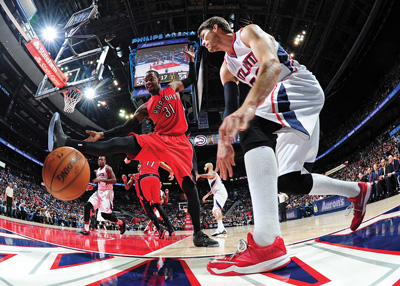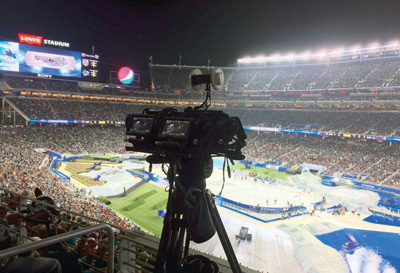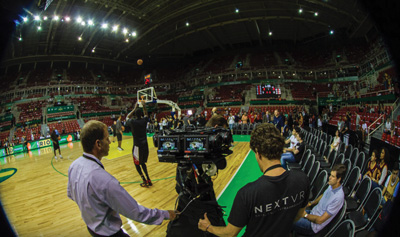Peter Guber remembers visiting Stanford University’s Virtual Human Interaction Lab about a year ago, putting on a virtual reality headset and being completely blown away.
“It was a whole new experience. I was completely transported to that other place,” recalls Guber, co-owner of the Los Angeles Dodgers and Golden State Warriors and head of Mandalay Entertainment. “And any time you can create something completely brand new like that, a new opportunity and new way for a fan to be involved, I thought it was worth investing into that. I think this is something right in the crosshairs of the future.”
 |
The courtside perspective as seen through a virtual reality camera.
Photo by: NBAE / GETTY IMAGES
|
Guber recently made an undisclosed seven-figure investment he termed “very significant” into NextVR, a California-based technology company working to enable VR experiences for major sports leagues and networks.
His involvement, in which he also will chair an advisory board for NextVR, is just a hint at the sports industry’s rapidly accelerating interest in virtual reality, which offers an immersive 360-degree viewing experience. Through virtual reality, fans can get the feeling
{podcast}
SBJ Podcast Archive:
From Jan. 5: Senior writer Bill King and Assistant Managing Editor Tom Stinson discuss Peter Guber.
of sitting courtside at an NBA game, directly behind the glass at an NHL game or inside the cockpit with a NASCAR driver. Far beyond just an enhanced version of a regular game broadcast, virtual reality seeks to provide a deeper sensory experience, re-create the feeling of being physically present in the stadium or arena, and offer a new way for fans to engage with their favorite sports.
And unlike a typical sports broadcast, where a director makes all the decisions on what a viewer sees, a fan in virtual reality has total control over where they choose to focus.
“Sports is the holy grail for virtual reality,” said Brad Allen, NextVR executive chairman. Allen has worked in investment banking, funding early-stage technologies, for more than three decades but says, “I’ve never seen so many chief executives, commissioners, people at that level, all get excited about the same thing.”
Virtual reality as a technology has existed in various forms for five decades, and is common in military and aviation circles. But as a mainstream consumer product, it’s never caught on — until now.
Spurred in part by recent technical advances and Facebook’s $2 billion purchase early last year of Oculus VR — in essence a huge bet by Mark Zuckerberg, Facebook co-founder, chairman and CEO, on virtual reality becoming the next major digital platform — a bevy of sports and media properties are actively seeking to develop their own presence in the space in preparation for a mass-market adoption widely projected to arrive in 2016.
In recent months, the NBA, NHL, NASCAR, MLB and Fox Sports all have conducted tests with content produced in virtual reality, including live events, and are seeking to develop public offerings in the format.
The NBA showcased the technology and its work with Oculus and consumer electronics giant Samsung during its All-Star Game earlier this year in New York, further highlighting virtual reality’s importance to the sports industry. That occurred just days after Commissioner Adam Silver made his own visit to Stanford, like Guber, for a firsthand experience.
Highlight clips from that All-Star Game weekend are available through Samsung’s Milk VR virtual reality application, a prelude to an expected sharp increase in available content next year.
“We’ve got fans all over the world,” said Jeff Marsilio, NBA vice president of global media and the league’s point man for virtual reality. “The reality is that very few of them are able to attend an NBA game, and even fewer of them have the opportunity sit courtside. So what virtual reality does is offer that type of experience to everyone.”
And it’s not just live game broadcasts and event highlights where virtual reality is beginning to have an effect. The technology is being eyed as the next great advance for coaching and training simulations. In the not-too-distant future, quarterbacks will be able to conduct a VR simulation with an oncoming blitz, not unlike how a fighter pilot prepares for combat. A company dedicated to virtual-reality-based coaching for football, Strivr Labs Inc., recently emerged out of the Stanford Virtual Human Interaction Lab, and the technology is expected to spread to other sports soon.
Media outlets also are beginning to incorporate virtual reality into their newsgathering operations. Gannett recently introduced to the public a mobile application, VR Stories, that takes its traditional storytelling to virtual reality. Among the initial deployments within VR Stories have been coverage of the Cincinnati Reds and Kentucky Derby through Gannett newspapers The Cincinnati Enquirer and The (Louisville) Courier-Journal.
“Our goal is to tell stories in new ways and find audiences navigating away from traditional media approaches,” said Mitch Gelman, Gannett Digital’s vice president of product. “Our position is that we’re storytellers, and this is a new way to do it.”
Getting social right
Watching sports in most instances is a deeply social experience, and VR’s unsuccessful predecessor, 3-D TV, was doomed in part by its inability to foster that interaction while wearing the glasses (see related story).
Zuckerberg and Facebook, conversely, saw virtual reality as an inherently social possibility when it bought Oculus VR, and VR developers are actively working to address the “isolation issue.”
Efforts are underway to incorporate vocal interaction and access to social networks directly within virtual reality.
Even deeper applications, such as people virtually attending social occasions (including a game) together, are being contemplated.
“Hooking with the social graph is a deeply important part of this,” said Doug Perlman, founder and chief executive of Sports Media Advisors, which is working with NextVR on its development efforts. “This will wind up being a very social thing.”
 |
The NHL conducted a VR test at its Stadium Series game at Levi’s Stadium this year.
Photo by: NEXTVR |
At the time of the Oculus purchase, Zuckerberg predicted virtual reality would soon become a “part of daily life for billions of people,” largely due to that interaction component.
“This is really a new communication platform,” Zuckerberg said at the time of the announcement. “But feeling truly present, you can share unbounded spaces and experiences with the people in your life.”
Further aiding the development of VR content: It’s relatively easy to produce. As opposed to the low-position cameras, separate trucks and loss of facility seats typically required for game production in 3-D, shooting for virtual reality requires as little as a single and comparatively much smaller camera. And that camera can be placed in areas impossible to reach with a traditional setup, such as on top of an NBA scorer’s table, and operated remotely.
“The cost of entry is definitely not as high as 3-D,” said Mike Davies, Fox Sports senior vice president of field and technical operations. The network recently participated in a test of virtual reality for NASCAR at the Auto Club Speedway in California, and is considering similar experiments later this year for other sports it airs.
“We’re able to build a compelling experience from a single camera as opposed to a big, expensive, separate production like we had with 3-D,” he said.
Monetization matters
Even with that lower barrier to entry, the question immediately surfaces of how it will be funded and what a revenue model would look like. On the content side, initial tests such as what the NBA did in February with the All-Star VR content have been offered for free. Ultimately, though, leagues are eyeing a variety of subscription-based, on-demand and pay-per-view revenue models.
It’s still unknown how much VR programming viewers can comfortably watch in a single setting — the common view is that it’s less than they could on standard TV — so creating content packages is still in the embryonic stages.
“We’re still figuring out first what the ‘product’ is around virtual reality, and what the fans really want. That’s the first step,” the NBA’s Marsilio said. “I would be surprised if it doesn’t turn out to be a mixture of things.”
 |
VR production requires fewer, smaller cameras than 3-D.
Photo by: NEXTVR |
The NHL is in a similar position. The league has conducted several recent tests in virtual reality, including at its Stadium Series game earlier this year at Levi’s Stadium in California between the San Jose Sharks and Los Angeles Kings. But it has not yet progressed toward commercializing the platform.
“There’s a wow factor right away with this. We know that much,” said Bob Chesterman, NHL senior vice president of programming and production. “But the video quality still isn’t quite there yet, particularly on the live side. And we haven’t done all the due diligence yet on the business side that needs to happen. The technology still needs to catch up a bit. But things in this space are moving very fast. I would expect we’ll have a clearer direction in months, not years.”
Guber agreed.
“We’re still at a very early stage,” he said. “I don’t know yet where we’re going to net out at that end between the broadcasters, the leagues, the teams and so forth. That will be dealt with down the road. We’re not even at the start of the game with virtual reality, really. But there is value in this, no question, and it will definitely be monetized.”
Some media rights deals between sports properties and networks have legal language inclusive of all current and future video technologies, granting the networks the ability to exploit any new advancement of virtual reality. So in theory, a network such as ESPN that typically negotiates broad, platform-agnostic rights deals like that for itself could develop a VR content package to sell to the public. ESPN declined to detail its plans in virtual reality.
Other rights, comparatively, are more limited and do not necessarily contemplate virtual reality. So deployment to the public likely will be more on a case-by-case basis in the near term.
“This is a white-hot space that everybody is trying to understand,” Perlman said. “But the rights issues right now are a bit all over the place and are going to need to be sorted out.”
Game attendance, conversely, appears to be far less of an issue with virtual reality. Just as live attendance in sports mushroomed after the arrival of ubiquitous game coverage on TV, Guber and others see virtual reality as a powerful marketing tool to promote buying a ticket.
“I don’t see this as replacing the live attendance. Quite the contrary,” Guber said. “What better way to sell the allure of being there? And there’s unlimited capacity. The arena might only hold 18,000. But billions could watch through virtual reality. That presents a huge global opportunity, and something completely additive to the existing business structure.”
Advertising, meanwhile, is also a keen area of interest within virtual reality. Many entities are experimenting with virtual billboards, representing sort of an enhanced version of what is seen in traditional NHL game broadcasts and elsewhere. The type and placement of some of those ads probably will be determined in part by data that can be generated from where users focus their eyes within a VR broadcast.
Gannett thus far has gone down a more traditional route, selling a traditional, six-month presenting sponsorship to Cincinnati’s Christ Hospital for its VR coverage of the Reds. But other options include immersive forms of native advertising, more standard video spots and product placement.
“We’ve only begun to explore ways to integrate advertising into the VR experience,” Gelman said. “There are lots of different approaches we can take against this.”






